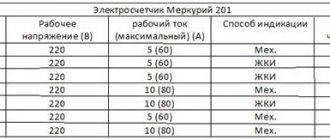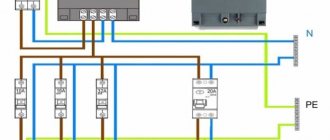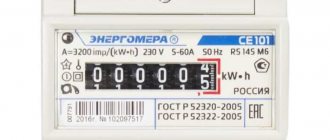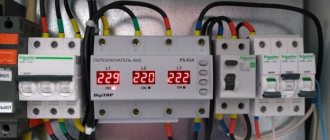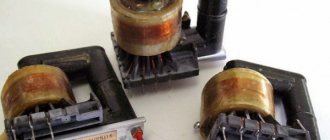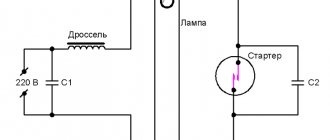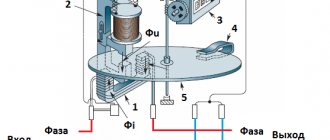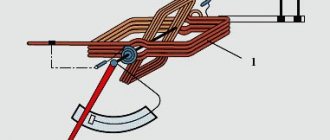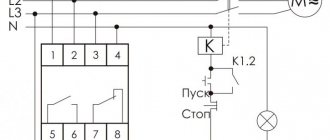How to choose an electricity meter
There are many devices on the market that record data on electrical energy consumption. It will be difficult for an inexperienced user to understand all the characteristics and choose the optimal device. First of all, you need to pay attention to the following criteria:
- For what current will the meter be used - alternating or direct.
- Single tariff or multi tariff.
- Data output method - electronic or mechanical.
- Which network will it be connected to - single-phase or three-phase?
Then a model is selected based on parameters such as load, operating current, cost, service life. You can find the best device for your home among Mercury products.
Description of Mercury electricity meters
Mercury meters are manufactured by the Russian company Incotex. The devices are available in various modifications, differing in their technical characteristics. The design of all models is the same. Externally, the meter looks like a rectangular plastic case with a liquid crystal screen. Mercury is screwless, so the possibility of unauthorized hacking of the metering device is excluded.
The standard package includes the electric meter itself, a passport and operating instructions. The device must have a hologram sticker, which can be used to determine that the device is original.
On the front side there is a display with which the readings are read. Nearby there is a plate with the technical characteristics of the electrical appliance. The bottom panel is removable and is used to protect the contacts. The connection is made using a screw connection. There is a sticker with a connection diagram on the back panel.
The electricity meter has compact dimensions of 105 x 105 x 65 mm. Its weight is approximately 250-350 grams. Mounts on a DIN rail without the use of additional fixing devices.
Description of the Mercury 201 meter
In order to connect the device, it is not at all necessary to call a specialist, because the entire procedure is quite feasible to do on your own. To do this, the meter is accompanied by detailed instructions where you can find information about its characteristics and installation principle.
The single-phase meter "Mercury 201" has been produced in Russia since 2001. More complex three-phase metering devices are also produced here. But if we talk specifically about Mercury, then there are two modifications, starting from 201.1 and ending with 201.8. In addition, the device may differ in the following parameters:
- according to permissible operating current;
- according to how energy consumption data will be reflected.
We bring to your attention an informative article about the history of the invention of electricity.
Design of the Mercury 201 device
Regardless of the modification of the meter, each of them has an identical design, consisting of the following parts:
- rectangular body made of durable plastic;
- depending on the modification, there is a small LCD display or drum on the front of the panel, which displays all the information about energy consumption;
- the right side of the meter is equipped with a table of technical parameters;
- the device itself has fairly compact dimensions of 105/105/65 cm;
- The weight of the electric meter is only 350 g.
At the bottom of the case you can find a removable structure, which is necessary to protect the contacts. In order to gain access to these contacts, you must remove the bottom of the device. The wires are connected to them using a screw connection.
The electric meter is attached to the wall, and for this purpose a special rail is included in its package. It is with its help that the metering device is installed on the desired surface.
Now a little more about the method of displaying information about energy consumption depending on the modification:
- all information is sent to an electromechanical display, where there is a special rotating drum;
- another modification of the electric meter is equipped with an LCD display, where all data is also displayed.
Specifications
An important distinctive feature of this device is that it is completely protected from deliberate theft of electricity using polarity reversal. For this, it has special protection, and this suggests that attempts to stop the counter are simply pointless
In addition, there are other characteristics:
- the device is able to operate uninterruptedly in harsh temperature conditions (minimum air temperature -22, maximum +50);
- the product goes on sale with a warranty period of 3 years;
- the meter itself, after installation, can operate properly for up to 30 years;
- the inter-inspection period is 15 years.
Basic requirements for the device
Before installing a newly purchased Mercury 201 electricity meter, you need to make sure that it fully complies with all the requirements specified in the documents attached to it:
- the device must belong to the first or second class of reading accuracy, where the permissible error varies from 1% to 2%;
- the device must also indicate the date of production of the device and the date of its inspection;
- the meter must have its own identification number, by which it can be found in the State Register of Metering Devices;
- there must be a warranty seal;
- the device must have a special hologram, which is necessary to protect the device from counterfeiting, as well as a stamp with the date of inspection.
Passport for Mercury 201
If you carefully read the passport for this meter, you can see that the manufacturer produces different variations of the device:
- the maximum current can be 60A or 80A;
- modifications 201.5, 201.6 and 201.7 do not have an LCD display, instead a mechanical drum is installed;
- modifications 201.2, 201.4 and 201.8, in turn, are equipped with LCD displays;
- some devices may be equipped with a special modem, with which readings can be taken remotely;
- transmitted pulses may vary from device to device.
All these characteristics and modification options can be found on specialized websites.
Basic requirements for the meter
When buying a Mercury electric meter, you should make sure that it meets the following criteria:
- Accuracy class first or second. The error should be 1-2%, no more.
- The meter must indicate the date of issue and inspection. These data must match those recorded in the passport.
- Availability of an identification number by which you can find the meter in the State Register. The number on the case must match what is written in the passport and warranty card.
- There is a protective hologram.
- The warranty seal must not be damaged or broken.
Only after checking compliance with all these factors can you make a purchase.
Requirements for the meter
Before purchasing an electric meter, you need to check whether it meets all the necessary requirements. This includes the presence of an accuracy class, usually for electricity metering devices this is the first or second class, which allows a measurement error of 1-2%.
It is also worth checking in advance whether the date of production and verification of the meter is indicated. It is imperative to check the number for availability in the State Register database of measuring instruments and the warranty seal on the device itself. And it’s worth making sure that you have the verifier’s mark and a protective hologram.
Basic and additional characteristics
The technical characteristics of each modification are different. They have different parameters such as maximum permissible load, operating voltage, operating current, indication method and gear ratio.
Additional features include:
- Operating temperature range. Average values from -20 to +55. On some modifications, the minimum temperature is -40 - usually on devices with drums on which energy consumption is displayed. At temperatures below -20 degrees, the clarity of the image on the LCD monitor is lost.
- Operating conditions of the device.
- Warranty period. The average is 36 months.
- Life time. The meters last for 30 years.
- Intervalidation interval. When purchasing, you need to make sure that the electric meter has been tested after release. Then inspections are carried out by an inspector. The Mercury 201 electricity meter is verified once every 15 years.
In a number of models, it is possible to install not a liquid crystal screen, but a mechanical counting unit. There are also PLC models for recording all device changes.
Specifications
The model range is designed according to technical characteristics so as to take into account the active energy in the alternating current circuit and work even in autonomous mode. The meters differ from each other in accuracy class, rated voltage, rated current, network frequency, starting sensitive current, total voltage consumed by the circuit, display device, gear ratio, power network interface, operating temperature range and service life. The difference also lies in weight, calibration interval and manufacturer’s warranty.
It is worth pointing out that the Mercury 201.5 electricity meter is the most common model. It differs from other models in its technological reserve, small dimensions, screwless counting housing, current shunt, pulse telemetric output, polarity reversal, rail mounting and equipment. It is not necessary to check its operation, because the model is made with high quality, as is the transformer that goes to it.
Technical characteristics of the electricity meter Mercury 201
Advantages of Mercury meters
The Mercury 201 electric meter is popular due to a number of advantages:
- low cost - the minimum price is 600 rubles;
- specifications;
- high accuracy of electricity measurements;
- protection against energy theft, implemented using polarity reversal: when reversing the phase and zero, the device will also read the consumed electricity with high accuracy;
- compact dimensions;
- ease of installation without the use of additional fasteners;
- ease of use;
- burglary protection;
- sealed mechanism.
It is also worth noting the long service life of the device. With proper operation, the electric meter will operate for at least 30 years.
Mercury 201 - counting meter readings
Hello, dear readers, today our topic of the day is the Mercury 201 electric meter. This is a single-phase, single-tariff meter. It is very common in the household segment, as it attracts with its inexpensive price.
The digit capacity of the reading mechanism is 6 characters. The varieties of this meter are as follows: 201.2,4,5,6,22 and recent new products 201.7,8 - this is a multi-tariff version of the meter. The accuracy class of the device corresponds to state standards and is equal to 1. The calibration interval of this electricity meter is 16 years. The service life of the device is 30 years. The manufacturer provides a 3-year warranty on this meter model.
Types of models
The Mercury 201 counter is presented in several modifications. They differ in limit and normal current, value display panel and gear ratio. Specifications:
- 201.1 has a working current of 5 A, a maximum current of 60 A. Data is output mechanically.
- 201.2 has the same characteristics as 201.1, but the data is displayed on an LCD panel.
- 201.22 is similar to 201.2, differs only in power indicators.
- 201.3 operating current 10 A, maximum 80 A. Data is read using the electromechanical method.
- 201.4 is similar to 201.3, but the energy consumed is displayed on the LCD screen.
- 201.5 normal current 5 A, maximum 60 A. Mechanical indication. It differs in the gear ratio - 3200 imp./kWh instead of 6400 imp./kWh.
- 201.6 is similar to 201.5, but differs in an operating current of 10 A and a maximum permissible current of 80 A.
Varieties of this counter
This model is available in 7 versions, differing in current ratings and screen types. Below are the available versions of the device, indicating the differences.
201.1
The operating and limiting current values are 5 and 60 A, respectively; a mechanical method of displaying information is used.
We recommend: Electric meter Neva 114 - description and installation of the meter
201.2
The current characteristics are similar to the above version, the screen is liquid crystal.
201.22
It differs from the above model in power indicators, other parameters are identical.
201.3
Current characteristics according to normal and limit values are 10 and 80 A, respectively, the counting device is electromechanical.
201.4
A complete analogue of the previous model, with the exception of the screen design - liquid crystal.
201.5
Electric current values: 5 A - normal, 60 A - maximum, the mechanical method of displaying information, unlike all the listed models, is characterized by a gear ratio in the ratio of the number of pulses to kilowatt-hours - 3200 instead of 6400.
201.6
The differences with the above model are only in the current indicators - 10 and 80 A, other parameters are identical.
Connecting a single-phase meter
You can install the meter yourself without calling a technician. This is a fairly simple procedure - the connection diagram is on the device itself, it is only important to connect the wires correctly.
The Mercury 201 counter has the following contacts:
- two contacts for connecting the phase - for input and output;
- terminal for connecting zero;
- terminal for outputting zero to the load.
All wires must be connected in the sequence indicated on the body. The circuit of the Mercury 201 counter is the same as that of other modifications. It is important to turn off the power to the apartment before starting installation. Working under voltage is prohibited.
The first step is to remove the protective cover. On the second, you need to loosen the clamps, strip the insulation on each wire and proceed to the connection. The phases are turned on first, then the neutral conductors. Then you need to tighten the screws securely. The last step is screwing on the lid. When assembled correctly, the red indicator LED next to the screen should light up. If it does not light, you should call an electrician.
Source
Connecting the meter
Before installing the meter, the following details are agreed upon with the energy supply company:
- Installation location. This is usually done outside the apartment or house, but installation can also be done inside.
- Model of the installed meter. Here you will need technical documents that were received upon purchase.
- Checking the quality of the electrical connection and wiring diagram.
Before connecting the meter, you need to carefully study the technical data sheet for the product, and also clarify the connection diagram. If the master is unsure of his abilities, then it is necessary to use the services of professionals. Very often, many questions arise regarding how to connect the Mercury-201 meter, but in fact there are no particular difficulties in this process.
A single-phase device is designed to include the following input contacts:
- Contact for entering a phase into the room from an external network. The wire is obtained from the electricity supplier.
- The ShVVP cable is intended for phase output into the connected room.
- Terminal for connecting zero from the general network.
- Zero output terminal to load inside.
All wires are connected in the specified sequence.
Important! Before starting work, the system is de-energized. To do this, turn off the switch, the machine, the plugs and the cable itself if it goes to the meter.
The connected wires are neatly arranged on the terminal cover using perforated cells. The cover itself is mounted on the body as tightly as possible.
After this, you need to once again make sure that the connection diagram has been followed and call a representative of the electric company who will carry out verification and install the appropriate seal on the meter.
Important! If the red light on the electric meter is on, this means it is connected to the electrical network.
Most Russians use the Mercury 201 meter to calculate electricity. These devices are installed in almost every apartment building in the country, and they are chosen, first of all, for their attractive price: depending on the region, it can vary from 550 to 600 rubles.
Mercury 201 is a single-phase electricity meter that replaced the old meters with spinning disks.
General information
Before connecting a single-phase electricity meter Mercury 201, it is necessary to study in detail its design, principle of operation, technical characteristics, as well as the main advantages and disadvantages. All this information will help you choose the most effective modification of the device, which is ideal for each specific room.
Components
In order to connect Mercury 201, it is necessary to consider its components. The design of the device is distinguished by its simplicity. It can be easily understood not only by a highly qualified electrician, but also by a beginner who sees this product for the first time.
Design features and connection diagram
The device consists of a plastic case, a cover, a terminal block, an optocoupler, a volatile memory device, an optoport, a microprocessor and a liquid crystal monitor. There are two connection options. Can be connected directly or semi-indirectly using current three-phase transformer installations. As for direct connection, the device is connected directly to the power line according to the instructions using input machines.
You might be interested in Grounding an electrical panel
Note! As for semi-indirect connection and installation, this circuit uses a phase network conductor. It is worth pointing out that there is also an autotransformer, indicated in the diagram.
Mercury connection 201
Self-installation method
In order for the electricity meter to work efficiently over a long period, you need to install it correctly. To carry out the work yourself, you should perform several preparatory measures that will help speed up the process and achieve the desired result.
Procedure:
- The energy supply company obtains permission to independently remove the old meter. In addition, information about the required accuracy class of the new device is clarified.
- As soon as all the documents are ready, you need to purchase a Mercury 201 meter. You can find it in specialized stores in any locality.
- The location where the new electricity meter will be located is selected. Experienced electricians recommend giving preference to that part of the wall where there will be no even minimal chance of moisture getting into the device. In addition, the place should be close to the entrance to the apartment, which will greatly simplify the process of connecting wires.
- At the next stage of work, the dimensions of the meter are measured and the corresponding markings are made on the wall.
- Using a simple pencil or marker, mark the places where the holes for fastenings will be located.
- After this, drilling is performed, and the electric meter is securely fastened with screws.
- The installed device is checked for evenness in the vertical and horizontal planes.
- The room is completely de-energized and the presence of voltage in the network is checked. This work is easiest to do with an indicator screwdriver.
- Wires are led from the distribution board to the installed electric meter.
- There they are connected according to the standard scheme and securely fixed.
- A phase is attached to the residual current device (fuse or circuit breakers), and a zero is attached to the terminal panel. In this case, gently connect the phase to the second terminal from the right, and the zero to the first on the same side.
- The device is checked for visible damage and uninsulated contacts.
- At the very end, an application for sealing the Mercury 201 meter is written.
- A few days later, a specialist from the energy supply company comes and checks that the meter is connected correctly to the power grid.
- If everything is done perfectly, the device is tested for functionality.
- If there are no problems, the meter is sealed.
After completing all stages of the procedure, the device will be considered authorized for use. Its owner can monitor the readings and, if necessary, reduce or increase the amount of electricity consumed.
Features in design
Structurally, all electricity meters of the 201 series are made in the same type of rectangular plastic housing. Based on the model range, they can be electromechanical or electronic. In the first case, the reading system is a drum, in the second - a liquid crystal display. Both the drum and the display are located on the front panel on the left, and on the right is a table with technical characteristics. The screwless device of the Mercury 201 electric meter protects it as much as possible from break-ins and ensures sufficient tightness.
The device is compact and is fixed on a wall or other surface using a DIN rail. This mounting option is the most reliable.
The design of the lower part of the housing is removable and is designed to protect the contacts, which can be accessed after removing the cover. The wires are connected with a screw connection.
To determine how much space the Mercury 201 series meter takes up in the electrical panel, you need to know the number of modules of the device. It may not be the same for different models. There are cases when electrical panels do not fit the dimensions of the metering device, and special holes have to be cut for them. Only in this case is it possible to firmly mount the electric meter inside the panel on a DIN rail. You can find out how many modules the Mercury 201 counter occupies by reading the parameters of its modifications.
Description and design features
The start of production of these devices was given at the factories of the Incotex company in 2001. They have become a good replacement for old-style models equipped with a spinning disk, and the service life of these meters is almost thirty years, which suits every buyer.
In addition to several modifications, Mercury 201 is classified according to the following parameters:
- permissible operating current;
- diagram for displaying information about electricity consumption.
By design, all models of this electric meter are similar to each other and are arranged as follows:
- plastic compact rectangular body;
- drum or liquid crystal screen with data on electrical consumption. energies are located on the front panel on the left side;
- a table with technical parameters is located on the right side of the same panel;
- The weight of the device is no more than 350 grams.
Input email The contacts at the bottom of the meter are protected by a removable structure. A DIN rail is used to fix the device on a wall or other surface.
The standard equipment of the Mercury 201 electricity meter consists of:
- Directly from the device.
- Documentation for it (technical passport, operating manual).
Additionally, some Mercury models can be equipped with GPS modules for taking readings online.
The authenticity of the Mercury 201 meter can be determined by the presence of a holographic sticker (seal) on it with information about the release date.
Self-installation and connection of the device does not take much time. The only rule is to carefully read the operating instructions and data sheet for it before installation. For repairs, in the event of a malfunction, it is better to invite qualified specialists.
Basic and additional characteristics
There are differences in the technical characteristics of the device depending on the model, but the common feature for meters of the 201 series is accuracy class 1. This meets the requirements of regulatory documents (no more than 2) and indicates a small measurement error. The device is protected by a polarity reversal system from the possibility of external influence on its operation. You cannot stop the device or affect the accuracy of the data.
- rated mains voltage – 230 V;
- rated current – 5(60) – 10(80) A;
- sensitivity threshold – 10/20/40 mA;
- temperature range within -40…+75⁰С;
- weight – 0.25 (0.35) kg.
- service life – 30 years;
- The warranty period is 3 years.
Single-phase single-tariff meters "Mercury 201", "Mercury 202", "Mercury 203"
MERCURY 201
Mercury 201 meters are used for commercial metering of active electricity in single-phase alternating current circuits with a voltage of 230V and a frequency of 50Hz. The Mercury 201 meter can operate autonomously or as part of an AIMS KUE. Installation - on DIN rail. Accuracy class - 2.0(1.0). Overall dimensions - 105x105x64 mm. Weight - 0.35 kg. The inter-verification interval is 16 years. Service life - 30 years.
Additional characteristics for Mercury 201 meter models
| Options | 201.2 | 201.4 | 201.5 | 201.6 | 201.22 |
| Rated (maximum) current, A | 5(60) | 10(80) | 5(60) | 10(80) | 5(60) |
| Sensitivity at Ibase=5A/10A, mA | 20/40 | 20/40 | 20/40 | 20/40 | 20/40 |
| Active (apparent) power consumption, W (VA) | 2(10) | 2(10) | 2(10) | 2(10) | 1,5(15) |
| Display device | LCD | LCD | OU | OU | LCD |
| Gear ratio, imp./kW-hour | 6400 | 6400 | 3200 | 3200 | 6400 |
| PLC modem | — | — | — | — | + |
| Operating temperature range, C | -20…+55 | -20…+55 | -40…+55 | -40…+55 | -20…+55 |
Overall dimensions of Mercury 201 meters
MERCURY 202
Mercury 202 meters are used for commercial metering of active electricity in single-phase alternating current circuits with a voltage of 230V and a frequency of 50Hz. The Mercury 202 meter can operate autonomously or as part of an ASKUE system. Accuracy class - 1.0. Overall dimensions - 204x119x56 mm. The overall and connecting dimensions of Mercury 202 meters coincide with the corresponding dimensions of induction meters. Weight - 0.25 kg. The inter-verification interval is 16 years. Service life - 30 years.
Additional characteristics for Mercury 202 meter models
| Options | 202.5 | 202.22 |
| Rated (maximum) current, A | 5(60) | 5(60) |
| Sensitivity at Ibase=5A/10A, mA | 20/40 | 20/40 |
| Active (apparent) power consumption, W (VA) | 2(10) | 1,5(15) |
| Display device | OU | LCD |
| Gear ratio, imp./kW-hour | 3200 | 5000 |
| PLC modem | — | + |
| Operating temperature range, C | -40…+55 | -40…+55 |
Overall dimensions of Mercury 202 meters
MERCURY 203
Mercury 203 meters are used for commercial metering of active electricity in single-phase alternating current circuits with a voltage of 230V and a frequency of 50Hz. The Mercury 203 meter can operate autonomously or as part of an ASKUE system. Advanced LED indication - “Network”, “Ground”, “Reverse”, “1600 imp/kwh”. Accuracy class - 1.0. Overall dimensions - 185x125x56 mm. The overall and connecting dimensions of Mercury 203 meters coincide with the corresponding dimensions of induction meters. Weight - 0.7 kg. The inter-verification interval is 16 years. Service life - 30 years.
Additional characteristics of the Mercury 203.1 meter
| Options | 203.1 |
| Rated (maximum) current, A | 5(80) |
| Sensitivity, mA | 20 |
| Active (apparent) power consumption, W (VA) | 2(10) |
| Display device | OU |
| Gear ratio, imp./kW-hour | 1600 |
| PLC modem | — |
| Operating temperature range, C | -40…+55 |
Overall dimensions of Mercury 203 meters
Return to list
Modifications
The single-phase electronic meter Mercury 201 has 7 modifications: from 201.2 to 201.8, differing in the value of the rated and starting current, power consumption, method of data display, operating temperature range, number of modules, dimensions and weight. The remaining indicators of devices in this series are the same.
If you go by price, the cost of the meter is most affordable when equipped with a drum reading device. Such devices are simple to implement, they have the lowest transfer number of pulses per kW/h - 3200, sensitivity indicators are 10, 20 or 40 mA, power consumption - 2 W. In addition to its reasonable cost, the device is in demand for its reliability, resistance to overloads and long service life.
Among the devices in this series, the most popular models are the Mercury 201 5 and 201 7 electricity meters, which differ from each other only in overall dimensions and weight. The dimensions of the counter of the first model are 65x105x105 mm, the second - 66x77x91 mm. The difference in weight is 100 g (350 versus 250). If the differences in weight are not so significant, then the dimensions are important for the correct selection of the electrical panel and ease of installation. The advantage of Mercury 201 7 is that it occupies not 6, but only 4.5 modules. This saves space in the shield, does not require additional cutouts and is aesthetically pleasing.
The electricity meter can be equipped with a remote control (RC). To do this, a programmable module is installed inside the device, which responds exclusively to receiving remote control signals. After installing the microcontroller, when you press the remote control button, the recording of readings is interrupted, while electricity is supplied to the room, and the indicator continues to signal that the device is operating in normal mode. There are no signs of external interference in the functioning of the devices.
The Mercury 201 meter with a remote control allows you to save up to 50% of electricity.
Externally, the remote control is similar to a car alarm key fob and allows you to control the operation of the device from a distance of up to 50 m.
To select an economical operating option, you need to turn on the remote control in undercounting mode. It is advisable to pay attention to the number of blinks of the indicator when the counter switches. There should be from 3 to 30. The device works normally if after 2 and 3 flashes of the indicator the counting mechanism remains in place.
The microcontroller is set to a frequency of 315 MHz, which allows it to operate without failures.
When the saving function is disabled, the meter operates in factory mode.
Connection diagram
The Mercury 201 brand meter is connected without any special features, similar to other electrical energy metering devices. The device comes with detailed instructions that need to be studied, along with a passport and connection diagram. The main thing is the correct connection of the phases and attention when connecting the wires (their markings are highlighted in different colors).
Before connecting Mercury 201, it is necessary to de-energize the system: turn off the machine, switch, and supply line. For safe laying of wires, special cells with perforated grooves are provided on the terminal cover. In these places, the cells are broken out, and a wire is inserted through the holes.
Types of devices
The operating principle of any meter is to measure active energy and calculate the energy spent.
There are several options for counters.
They share:
- according to the connection principle - to direct and transformer connected devices;
- according to measured values - single-phase and three-phase;
- by design - mechanical, electronic and hybrid;
- by the number of tariffs - single-tariff and multi-tariff.
Basically, electronic devices are used to account for electricity, which have a number of advantages: they are more accurate and allow the use of several tariffs, to which they are transferred independently, without the participation of the owners.
How does it work
Electrical metering is based on direct measurement of voltage and current: all information about electricity consumption is supplied to the indicator and stored in the device’s memory.
At the same time, the device has a number of advantages:
- It allows information to be read more accurately, which prevents electricity theft.
- It is smaller in size compared to mechanical ones.
- Can automatically switch between different tariffs without requiring human presence, which saves money.
- Electronic models are checked every 4-16 years. This is necessary to verify the correctness of the accruals. The verification is carried out by the Sphere of State Regulation of Ensuring the Uniformity of Measurements.
Schematic diagram of an electronic meter.
(Click to enlarge) Electricity is calculated by converting the current and voltage signals “entering” the device into a pulse, which it counts.
The number of the latter varies in accordance with the incoming energy. That is, the more electricity is consumed, the more impulse the device will receive and count.
Together with the counting device, the electronic meter has a display that reflects changes in current consumption, maximum and minimum values, the current tariff and other data necessary for the owners.
You may be interested in an article about two-tariff electricity meters.
Read the article on how to take readings from a three-tariff electric meter here.
What to do if you detect a malfunction of the electric meter
All information about the user’s electricity consumption is stored in the device’s memory. However, this device also has disadvantages - a lower level of safety and service life. Frequent breakdowns cause the system to operate incorrectly, and electricity readings become higher.
All information on the All-Electricity website is provided for informational and educational purposes. The site administration is not responsible for the use of this information.
Contact is broken for the following reasons:
- Weak bolt fastening. You just need to tighten it all the way.
- Burnt wiring. The damaged area is cut off, a new fastening is made: the insulation is removed, the wire is stripped, and connected with a bolt.
- Oxidation can be eliminated in one of the following ways: by cleaning with a knife or sandpaper, using acid for etching, simply cutting off the damaged area and assembling a new contact.
